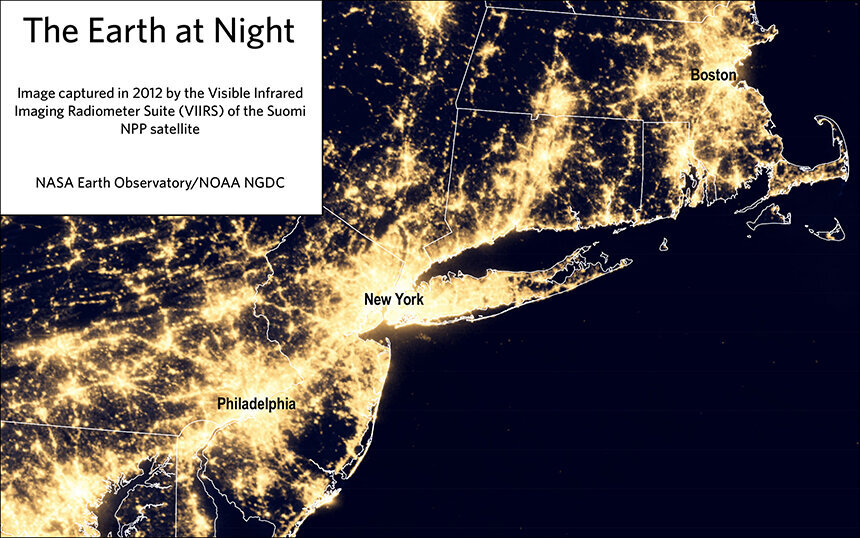
Much of southern New England isn’t all that dark at night. (NASA)
By TODD McLEISH/ecoRI News contributor
Global insect populations have declined by as much as 75 percent during the past 50 years, according to scientists, potentially leading to catastrophic impacts on wildlife, the environment and human health. Most studies point to habitat loss, climate change, industrial farming and pesticide use as the main factors driving the loss of insects, but a new study in the United Kingdom points to another cause: light pollution.
The ever-increasing glow of artificial light from street lights, especially LED lights, was found to have detrimental effects on the behavior of moths, resulting in a reduction in caterpillar numbers by half. And since birds and other wildlife rely on caterpillars as an important food source, the consequences of this decline could be devastating.
According to Douglas Boyes of the UK Centre for Ecology & Hydrology, street lights cause nocturnal moths to postpone laying their eggs while also making the insects more visible to predators such as bats. In addition, caterpillars that hatch near artificial light exhibit abnormal feeding behavior.
But moths are not the only wildlife affected by artificial light.
Since most songbirds migrate at night, birds that have evolved to use the moon and stars as navigational tools during migration often become disoriented when flying over a landscape illuminated with artificial light.
“City centers that are very bright at night can act as attractants to migrating birds,” said ornithologist Charles Clarkson, director of avian research at the Audubon Society of Rhode Island. “They get pulled toward cities, and when they find themselves amid heavily lit buildings, they become disoriented, leading to a large number of window strikes and increased mortality.”
It is unclear why birds are attracted to lights, but studies have found increasing densities of migrating birds the closer one gets to cities.
“Birds probably see these cities on the horizon from a long distance, and they get pulled toward these locations en masse,” Clarkson said.
Street lights have also been found to be problematic to birds. Birds are active later into the evening when they are exposed to nearby artificial lighting at night, and they often sing later as well.
“Sometimes that might lead to more food availability, since lights attract insects,” Clarkson said. “But it also affects the physiology of the birds when they’re active when they should be sleeping. Some birds that live in heavily lit urban or suburban areas begin nesting earlier, too, up to a month earlier than they typically would. And that leads to a phenological mismatch between when food is traditionally available and when the chicks are hatching and need to be fed.”
Artificial lighting may cause other species to face a similar mismatch. Christopher Thawley, a lecturer and researcher in the Department of Biological Sciences at the University of Rhode Island, studied lizards in Florida and found not only that the reptiles advanced the onset of breeding when exposed to artificial light, but they also laid more eggs and even grew larger under artificial lighting conditions. Other kinds of wildlife could have comparable results.
“Light at night can sometimes mimic a longer day length, and a lot of animals use length of day as a cue for when to start breeding,” he said. “If they’re exposed to light at night, they think the days are longer so it must be time to breed. Length of daylight is also a good cue for when to migrate or when to start calling, and that could potentially be an issue for some species.”
Thawley said frogs that call at night near artificial light could be more vulnerable to predators.
“When nights are darker, frogs call more, and when the moon is bright they call less,” he said. “It’s more dangerous to call during a full moon because predators could see you. That would be especially true under artificial lighting conditions, too.”
Scientists are still trying to understand the intricacies of how light pollution impacts wildlife, and yet some cities are already taking action to reduce its impact. Dozens of cities around the United States and Canada, including Boston, New York, Chicago and Washington, D.C., have launched “lights out” programs aimed at dimming city lights during the peak of bird migration.
Providence is not among the cities participating in a “lights out” program, but local advocates have discussed how to get it started for several years. They say it would be a positive first step toward reducing the impact of artificial lighting on local and migrating wildlife.
Rhode Island resident and author Todd McLeish runs a wildlife blog.
"light" - Google News
September 30, 2021 at 05:10PM
https://ift.tt/3F1fxZj
Light Pollution's Glare Threatens All Kinds of Wildlife — ecoRI News - ecoRI news
"light" - Google News
https://ift.tt/2Wm8QLw
https://ift.tt/2Stbv5k
Bagikan Berita Ini














0 Response to "Light Pollution's Glare Threatens All Kinds of Wildlife — ecoRI News - ecoRI news"
Post a Comment